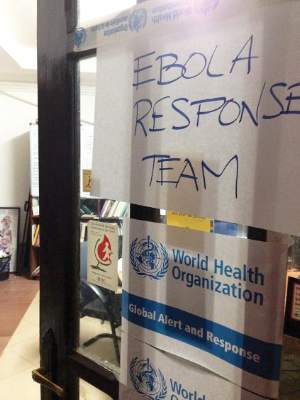The struggle to defeat Ebola virus disease continues globally, although it may not always make the headlines. To catch up on what you may have missed, here are some notable news items and journal articles published over the past few weeks that are worth a second look.
Plasmodium species parasitemia is associated with an increase in the probability of surviving Ebola virus infection, according to a study in Clinical Infectious Diseases. The authors said more research is needed to understand the molecular mechanism underlying this phenomenon and translate it into treatment options for Ebola virus infection.
A recent study found that a structured doffing protocol for health care providers wearing personal protective equipment, using a trained monitor and alcohol-based hand rub, protects against enveloped Ebola virus self-contamination. The authors noted that doffing protocols protective against all viruses need to incorporate highly effective glove and hand hygiene agents.
A reverse transcription loop-mediated isothermal amplification (RT-LAMP) assay for postmortem Ebola virus disease (EVD) testing was found useful as an EVD diagnostic testing method in the field or remote areas, according to a study in Guinea.
A structural study of the Ebola virus glycoprotein (GP) gene provides a detailed picture of the accessible Ebola virus glycoprotein landscape , according to investigators, and a structural basis to evaluate patient and vaccine antibody responses toward differently structured products of the GP gene.
A community-based strategy of social mobilization and community engagement was effective in case detection and reducing the extent of Ebola transmission in Sierra Leone, according to a report in Infectious Diseases of Poverty.
The Center of Excellence for Emerging Zoonotic and Animal Diseases, or CEEZAD, at Kansas State University, will use a $2.3 million grant from the U.S. Department of Defense to study the safety in livestock of a newly developed vaccine to protect humans from the Ebola Zaire virus.
An NIH study found that there is no difference in virus stability between the two strains of Zaire Ebola virus from the 1976 and 2013 outbreaks, and that viable virus can be recovered from an aerosol 180 minutes after it is generated.
According to a study in PLOS Medicine, the associations between war trauma and both EVD risk behaviors and EVD prevention behaviors may be mediated through two key mental health variables: depression and PTSD symptoms.
Inovio Pharmaceuticals announced its intention to more than double study enrollment to further characterize and identify in humans the most optimal immunization regimen using intradermal delivery of its preventive Ebola DNA vaccine.
Ordering clusters in a step-wedge Ebola virus vaccine trial based on the cluster’s underlying risk of infection , as predicted by a spatial model, can increase the statistical power of a stepped-wedge cluster study, according to a study in PLOS Neglected Tropical Diseases.
A Guinean study found that in survivors of EVD, CD16+ monocytes were activated during recovery , coincident with viral clearance, which suggests an important role of this cell subset in EVD pathophysiology.
Examining proactive vaccination strategies for Ebola prevention and response is critical to advancing development of vaccine production and administration technologies that could be instrumental to mitigating future Ebola outbreaks, according to an analysis in PLOS Neglected Tropical Diseases.
A study of the clinical features of Ebola virus disease in Sierra Leone showed that a better awareness of risk factors for death could be used to group EVD patients at greatest risk into dedicated wards with more intensive medical support.
Contact with individuals who died of EVD at home in rural communities in Liberia and Guinea resulted in more secondary infections than did contact with individuals admitted to Ebola treatment units, according to a study in Emerging Infectious Diseases.
A study of the 2014 Ebola virus disease outbreak in the Congo found that cycle threshold was a robust predictor of death , as were fever, hiccups, diarrhea, dyspnea, dehydration, disorientation, hematemesis, bloody feces during hospitalization, and anorexia in recent medical history.
A study published in Nature Microbiology demonstrated that researchers were able to protect nonhuman primates against a lethal Ebola Sudan infection when treatment began 4 days following infection.
Treatment of patients infected with Ebola virus disease in Sierra Leone with favipiravir (T-705) was associated with prolonged survival and markedly reduced viral load, according to a recent study, which makes a case for further randomized controlled trials of T-705 for treating EVD.
A study in the Journal of Infectious Diseases found that convalescent sera alone are not sufficient for providing 100% protection against lethal Zaire Ebola virus infection when administered at the onset of viremia.
On Twitter @richpizzi






